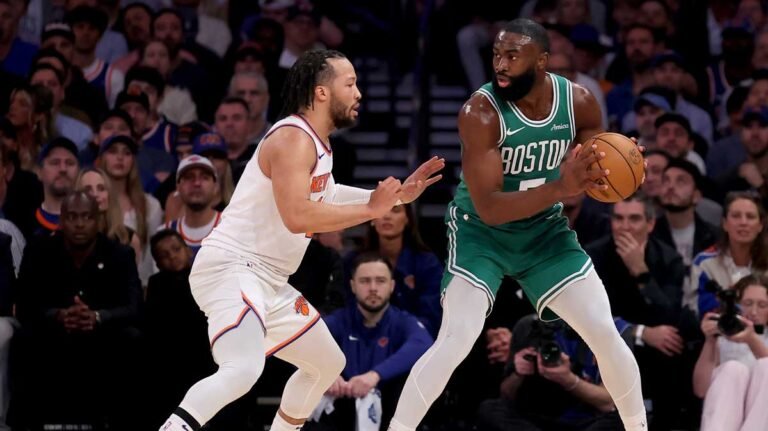How ‘Close’ Celtics Came to Trading Jaylen Brown, Derrick White Before Committing to Core Duo…read more…
The Boston Celtics are coming off one of the most dominant championship runs in recent NBA memory, but their journey to glory nearly took a drastically different path. According to multiple league sources, the Celtics seriously considered trading both Jaylen Brown and Derrick White in the past two seasons before ultimately choosing to double down on their core. Those internal discussions, while never made public until now, reveal just how fragile the foundation of a title team can be—even one that appeared so unified on the court.
Jaylen Brown’s Max Deal Almost Didn’t Happen
Last offseason, the Celtics made Jaylen Brown the highest-paid player in NBA history at the time by signing him to a five-year, $304 million supermax extension. But sources now confirm that the organization was not always 100% committed to locking Brown in long-term.
After Boston’s 2023 Eastern Conference Finals loss to the Miami Heat, frustration was mounting. Brown had struggled with turnovers and inefficiency, and some within the Celtics front office believed his playing style didn’t always complement Jayson Tatum. The front office explored trade possibilities that summer, including quiet inquiries with the Portland Trail Blazers and Brooklyn Nets.
Portland was reportedly open to a package involving Damian Lillard at the time, while Brooklyn inquired about a Brown-for-Bridges swap. Ultimately, Celtics President of Basketball Operations Brad Stevens decided to keep the two-way wing, citing Brown’s elite defense, improving playmaking, and value as a homegrown star.
“We did our diligence,” one Celtics executive told The Athletic. “But we always knew if we could get him to buy into the bigger vision, the upside was enormous.”
Derrick White Almost Dealt at the Deadline
Perhaps more surprising than the Brown news is how close the Celtics came to moving Derrick White ahead of the 2024 trade deadline.
White, who just signed a four-year, $125.9 million extension this summer, was seen as a strong candidate for inclusion in a potential deal for OG Anunoby or Dejounte Murray in mid-season talks. With Malcolm Brogdon injured and Marcus Smart already traded the previous summer, the Celtics were thin at guard. Yet there were concerns about White’s offensive aggressiveness and his ability to handle full-time playmaking duties.
The front office ultimately decided against a move, swayed by head coach Joe Mazzulla’s advocacy for White’s importance to the team’s defensive schemes.
“He’s our best communicator on defense,” Mazzulla reportedly told Stevens. “Losing him would set us back months.”
Instead of acquiring another high-usage guard, the Celtics focused on role-player additions like Xavier Tillman and Oshae Brissett, and they doubled down on continuity. That decision paid off in the form of one of the best team defensive ratings in playoff history, with White emerging as a key Finals contributor.
Close, But Not Close Enough
Though the Celtics entertained offers and ideas involving both Brown and White, the team was never “on the one-yard line,” as one source put it. Talks were exploratory and largely internal, with no concrete trade packages ever formally sent.
That said, the fact that both players came up in repeated conversations underscores how difficult team-building decisions can be in the NBA, especially for contenders. For a franchise as storied as the Celtics, expectations are sky-high, and championship windows can close fast.
“Every year you ask, ‘Is this the group?’” Stevens said in his championship press conference last month. “And for a while, we weren’t sure. But the guys earned the right to keep going.”
Brown and White Respond with Leadership
The gamble to stay the course proved to be the winning ticket. Brown was named 2024-25 NBA Finals MVP after averaging 23.6 points, 6.4 rebounds, and 5.1 assists during the postseason. His physicality and defense set the tone in the Celtics’ sweep of the Dallas Mavericks.
White, meanwhile, solidified his place as one of the league’s premier two-way guards. His timely three-point shooting, perimeter defense, and willingness to take on tough matchups allowed Boston to smother opposing offenses.
Both players appeared to have embraced the Celtics’ long-term commitment to them, with Brown openly discussing his leadership evolution and White calling Boston “the best basketball situation I could’ve ever asked for.”
What Could Have Been
It’s worth considering what the Celtics might look like today had they gone through with either trade. A Lillard deal would have drastically changed their offensive identity—perhaps at the cost of defensive dominance. A Brown-for-Bridges swap might have increased spacing and ball movement but likely sacrificed elite shot creation.
Similarly, replacing White with a more ball-dominant guard could have disrupted the Celtics’ offensive balance and leadership hierarchy. In hindsight, each potential move presented serious risks—risks the Celtics ultimately avoided.
The Bigger Picture
The Celtics’ near-deals are a reminder that championship rosters are not just shaped by the moves teams make, but also by the ones they don’t. In an era when blockbuster trades dominate headlines and front offices are often under pressure to “shake things up,” Boston’s patience stands out.
By trusting player development, fostering continuity, and making selective tweaks rather than sweeping changes, the Celtics created a culture that eventually translated into championship hardware.
Brad Stevens and the front office deserve credit for resisting the temptation to overreact to playoff heartbreak. So do Mazzulla and his staff for maximizing the group they had. But perhaps most of all, Brown and White deserve praise for continuing to grow—and proving their value when it mattered most.
In the end, the Celtics’ close calls became defining moments not because of t
he trades they made, but because of the ones they didn’t.



